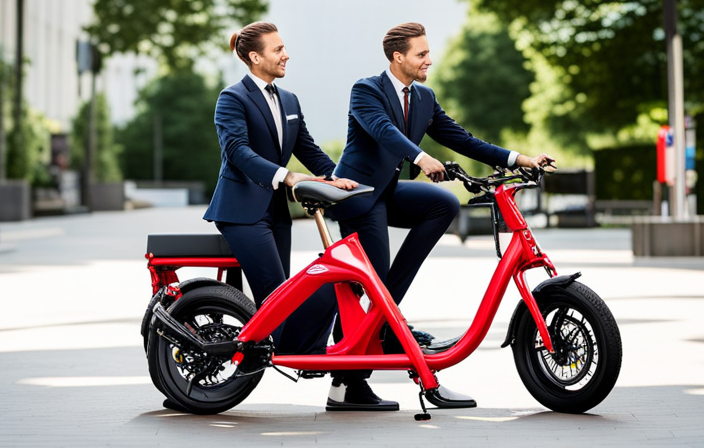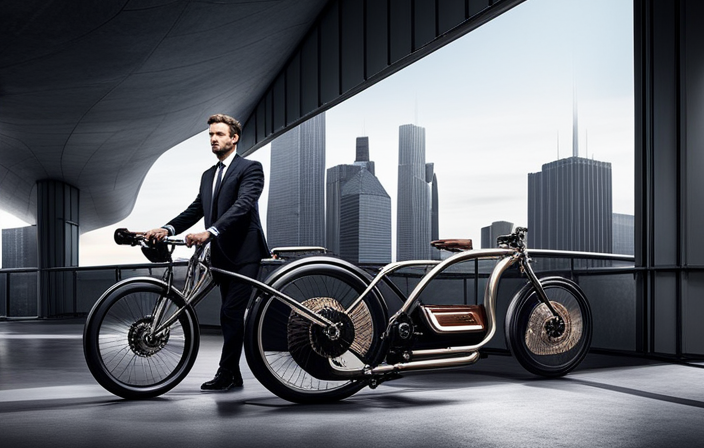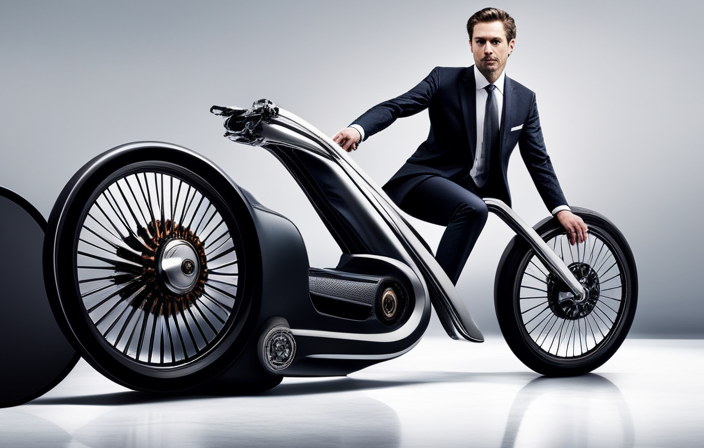To choose the right electric bike battery, first assess how far and often you plan to ride, considering terrain and weather conditions. Match the battery voltage with your motor’s specs for ideal performance, and select a capacity that fits your range needs. Pay attention to quality brands like Samsung or Panasonic for longevity. Ensuring compatibility with your bike’s components avoids issues, and understanding cost and maintenance helps you make a smart investment. Keep going to find out more about making the best choice.
Key Takeaways
- Determine your typical riding distance, terrain, and riding style to select an appropriate battery capacity and voltage.
- Match battery voltage with your motor specifications for optimal performance and compatibility.
- Choose high-quality lithium-ion batteries with sufficient Wh or Ah to meet your range needs.
- Ensure the battery fits your bike’s mounting options and connector types for safe installation.
- Invest in reputable brands with advanced BMS for safety, durability, and long-term cost savings.
Assessing Your Riding Needs and Range Expectations

To choose the right electric bike battery, you first need to assess your riding needs and how far you plan to go. Think about your typical riding distance and weekly mileage to determine the necessary battery capacity. Your terrain and riding conditions, such as hills or off-road routes, considerably affect energy consumption, meaning you might need a larger battery size for longer range. Consider your riding style—whether you’re commuting, leisurely riding, or hauling cargo—as this influences your preferred assist levels and battery performance. Also, account for environmental factors like cold weather, which can reduce mileage and battery efficiency. Understanding your range expectations helps you select a battery that provides adequate mileage at moderate assist levels, ensuring reliable performance without unnecessary weight. Additionally, the battery technology impacts overall efficiency and longevity, so choosing a modern, well-designed battery can improve your riding experience. Moreover, the versatility of hybrid bikes demonstrates how adaptable your setup can be to various terrains and riding conditions, emphasizing the importance of selecting a compatible and efficient battery system for your specific needs. Incorporating climate considerations into your choice ensures optimal battery performance across different environmental conditions, ultimately enhancing your riding experience. Considering suction power metrics can also help you understand how the battery contributes to overall motor performance and efficiency, which is especially important during changing gears on a gravel bike to optimize energy use.
Understanding Battery Voltage and Its Impact on Performance

When selecting an electric bike battery, understanding its voltage is key to optimizing performance. Battery voltage directly influences power output, top speeds, and hill climbing ability. Higher voltage batteries, like 48V compared to 36V, provide more vigorous acceleration and better ride responsiveness. Choosing a voltage within your motor’s compatibility guarantees smooth performance and avoids damage. Different voltage ratings—24V, 36V, 48V, and 52V—offer various benefits depending on your riding needs. Keep in mind that a higher voltage typically signifies increased overall performance, especially for demanding terrain or higher speeds. Matching the right voltage range with your motor will maximize your e-bike’s efficiency and riding experience. Additionally, GMC tuning techniques can optimize electrical systems to improve overall battery performance and lifespan. Being aware of battery specifications helps ensure compatibility and safety for your e-bike system. Moreover, understanding how AI advancements in battery management systems can enhance safety features is increasingly important for modern e-bike technology.
Selecting the Appropriate Capacity and Battery Type

Choosing the right battery capacity and type is essential for guaranteeing your e-bike meets your riding needs. Your battery capacity, measured in watt-hours (Wh) or ampere-hours (Ah), directly influences your riding range. Lithium-ion batteries are popular due to their high energy density, lightweight design, and long lifespan. Selecting the proper capacity depends on your typical distances: 360-720Wh suits daily commuting, while over 900Wh is better for touring. To illustrate, consider this:
| Battery Capacity | Typical Use | Battery Type |
|---|---|---|
| 360-720Wh | City commuting | Lithium-ion |
| 900Wh+ | Long-distance riding | Lithium-ion or NMC |
Matching capacity to motor power and riding needs ensures excellent energy use and longevity. Additionally, it’s important to consider the battery chemistry for compatibility and safety, especially when upgrading or replacing your battery. Understanding the energy density of different batteries can help optimize your e-bike’s performance and lifespan. Being aware of battery degradation over time can also assist in planning for replacements to maintain optimal performance. Moreover, selecting a battery management system can significantly extend the lifespan and safety of your e-bike battery.
Ensuring Compatibility With Your Bike’S Components
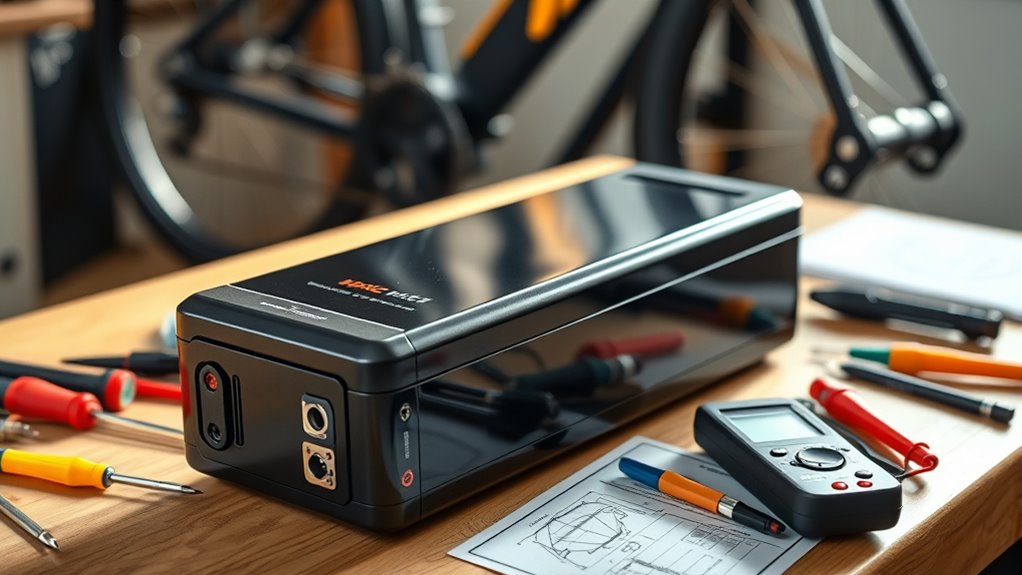
Matching your battery’s specifications with your bike’s existing components is key to guaranteeing smooth operation and safety. To achieve this, focus on battery compatibility by matching the motor voltage, such as 36V, with your battery’s voltage. Ensure the controller rating is equal to or higher than the battery’s voltage to prevent issues. The battery’s mounting type and size must fit your bike’s frame and design, whether rear rack or down tube mount. Also, check wiring configuration and battery connector compatibility to avoid connection problems. Consider the power draw and riding range to select a battery that meets your needs without over- or under-sizing. Proper alignment of these factors assures safe, efficient, and reliable performance. Additionally, understanding the specific tuning requirements for your bike’s components can help optimize performance and longevity. Regularly inspecting your battery connections and charging practices can further enhance safety and battery life. Being aware of retail operating hours, such as store opening and closing times, can assist in planning your maintenance or upgrade visits to ensure availability of assistance and products. Familiarity with battery safety precautions can further prevent potential hazards and ensure your riding experience remains secure.
Considering Cost, Quality, and Long-Term Maintenance
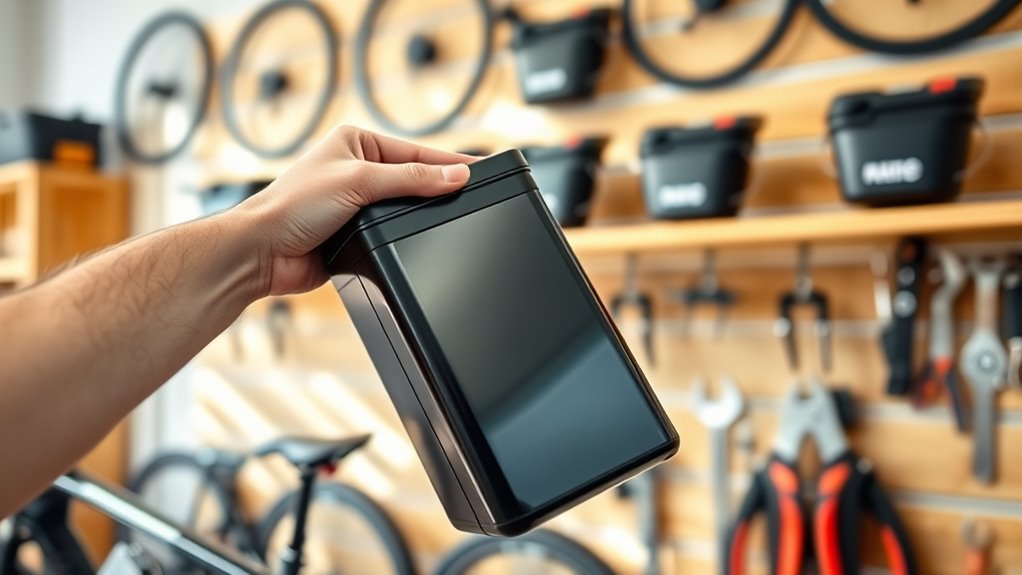
Considering cost, quality, and long-term maintenance is essential to making a smart investment in an e-bike battery. Higher-quality batteries from brands like Samsung or Panasonic offer longer battery life and fewer replacement cycles, providing better value over time. Investing in batteries with advanced BMS improves safety, extends lifespan, and reduces maintenance. Proper charging habits and storage practices also maximize battery lifespan and cost-effectiveness. Cheaper batteries may seem attractive initially but often degrade faster, requiring frequent replacements and risking safety. Additionally, selecting batteries with high-quality components can significantly impact overall durability and performance. Regular monitoring of battery health helps prevent unexpected failures and extends the usable life of your e-bike battery.
Frequently Asked Questions
Which Is Better, 48V or 52V Ebike Battery?
When comparing 48V and 52V e-bike batteries, you should consider your riding needs. If you want slightly higher speeds and better torque, the 52V battery offers those benefits, especially on challenging terrains. However, it’s larger and heavier, which might affect handling. For casual riding, a 48V battery can be sufficient. Choose based on your performance desires and compatibility with your bike’s components for the best ride experience.
What Size Ebike Battery Do I Need?
You need to think about your typical riding distance and terrain to choose the right e-bike battery size. For daily commutes under 20 miles, a 360-500Wh battery works well. If you ride on tough trails or take multi-day trips, opt for a larger 600Wh or more battery. Match the capacity with your motor’s voltage and riding style to get the best performance, balancing weight, cost, and practicality for your needs.
Which Is Better 36V or 48V Ebike Battery?
Did you know that 48V batteries can deliver up to 25% more power than 36V ones? When choosing between them, consider your riding style. If you mainly commute in the city or ride short distances, a 36V battery is lighter, cheaper, and easier to handle. But if you want better acceleration, hill climbing, and longer rides, a 48V battery offers higher performance and efficiency.
What Is the Best Battery Capacity for an Electric Bike?
The best battery capacity for your electric bike depends on how far you plan to ride. If you mainly commute short distances, a 10Ah or 360Wh battery should suffice. For longer trips or off-road adventures, consider a 15Ah or higher, like 720Wh, to get 40-50 miles of range. Balance your needs with weight and cost to choose the capacity that fits your riding style and terrain.
Conclusion
Choosing the right e-bike battery means balancing your riding needs, performance, and budget. For example, if you plan daily commutes, a higher capacity battery ensures you won’t run out of juice. Imagine Sarah, who upgraded her battery and now rides 50 miles comfortably without worries. By evaluating your range, compatibility, and quality, you’ll make a smart choice that keeps you riding smoothly and confidently for years to come.



